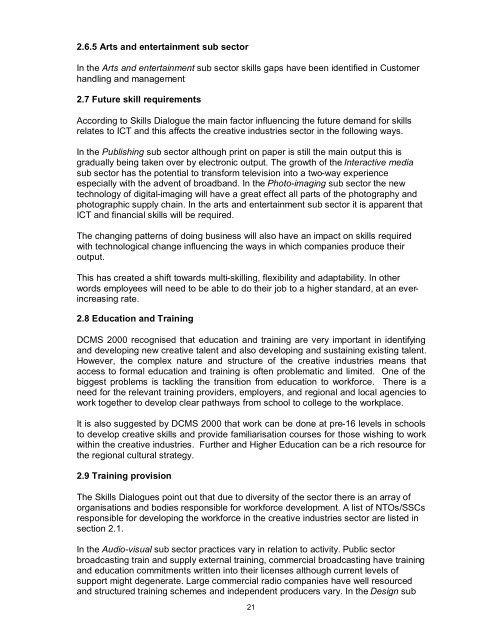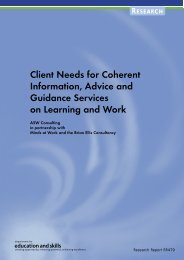An Introduction to the Creative Industries Sector - The Skills ...
An Introduction to the Creative Industries Sector - The Skills ...
An Introduction to the Creative Industries Sector - The Skills ...
You also want an ePaper? Increase the reach of your titles
YUMPU automatically turns print PDFs into web optimized ePapers that Google loves.
2.6.5 Arts and entertainment sub sec<strong>to</strong>rIn <strong>the</strong> Arts and entertainment sub sec<strong>to</strong>r skills gaps have been identified in Cus<strong>to</strong>merhandling and management2.7 Future skill requirementsAccording <strong>to</strong> <strong>Skills</strong> Dialogue <strong>the</strong> main fac<strong>to</strong>r influencing <strong>the</strong> future demand for skillsrelates <strong>to</strong> ICT and this affects <strong>the</strong> creative industries sec<strong>to</strong>r in <strong>the</strong> following ways.In <strong>the</strong> Publishing sub sec<strong>to</strong>r although print on paper is still <strong>the</strong> main output this isgradually being taken over by electronic output. <strong>The</strong> growth of <strong>the</strong> Interactive mediasub sec<strong>to</strong>r has <strong>the</strong> potential <strong>to</strong> transform television in<strong>to</strong> a two-way experienceespecially with <strong>the</strong> advent of broadband. In <strong>the</strong> Pho<strong>to</strong>-imaging sub sec<strong>to</strong>r <strong>the</strong> newtechnology of digital-imaging will have a great effect all parts of <strong>the</strong> pho<strong>to</strong>graphy andpho<strong>to</strong>graphic supply chain. In <strong>the</strong> arts and entertainment sub sec<strong>to</strong>r it is apparent thatICT and financial skills will be required.<strong>The</strong> changing patterns of doing business will also have an impact on skills requiredwith technological change influencing <strong>the</strong> ways in which companies produce <strong>the</strong>iroutput.This has created a shift <strong>to</strong>wards multi-skilling, flexibility and adaptability. In o<strong>the</strong>rwords employees will need <strong>to</strong> be able <strong>to</strong> do <strong>the</strong>ir job <strong>to</strong> a higher standard, at an everincreasingrate.2.8 Education and TrainingDCMS 2000 recognised that education and training are very important in identifyingand developing new creative talent and also developing and sustaining existing talent.However, <strong>the</strong> complex nature and structure of <strong>the</strong> creative industries means thataccess <strong>to</strong> formal education and training is often problematic and limited. One of <strong>the</strong>biggest problems is tackling <strong>the</strong> transition from education <strong>to</strong> workforce. <strong>The</strong>re is aneed for <strong>the</strong> relevant training providers, employers, and regional and local agencies <strong>to</strong>work <strong>to</strong>ge<strong>the</strong>r <strong>to</strong> develop clear pathways from school <strong>to</strong> college <strong>to</strong> <strong>the</strong> workplace.It is also suggested by DCMS 2000 that work can be done at pre-16 levels in schools<strong>to</strong> develop creative skills and provide familiarisation courses for those wishing <strong>to</strong> workwithin <strong>the</strong> creative industries. Fur<strong>the</strong>r and Higher Education can be a rich resource for<strong>the</strong> regional cultural strategy.2.9 Training provision<strong>The</strong> <strong>Skills</strong> Dialogues point out that due <strong>to</strong> diversity of <strong>the</strong> sec<strong>to</strong>r <strong>the</strong>re is an array oforganisations and bodies responsible for workforce development. A list of NTOs/SSCsresponsible for developing <strong>the</strong> workforce in <strong>the</strong> creative industries sec<strong>to</strong>r are listed insection 2.1.In <strong>the</strong> Audio-visual sub sec<strong>to</strong>r practices vary in relation <strong>to</strong> activity. Public sec<strong>to</strong>rbroadcasting train and supply external training, commercial broadcasting have trainingand education commitments written in<strong>to</strong> <strong>the</strong>ir licenses although current levels ofsupport might degenerate. Large commercial radio companies have well resourcedand structured training schemes and independent producers vary. In <strong>the</strong> Design sub21











